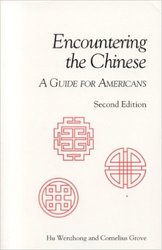Encountering the Chinese: A Guide for Americans by Hu Wenzhong and Cornelius L. Grove. Second Edition. Intercultural Press, Inc., Yarmouth, ME, 1999, 208 pp. ISBN 1877864587, paperback. Cost: $21.95 at <www.barnesandnoble.com>.
Reviewed by Sarah Doyle and G. Wright Doyle
Encountering the Chinese is, as the subtitle suggests, a guide designed specifically for Americans who plan to have prolonged interaction with people from the People’s Republic of China. The book is broken down into two main sections, one entitled “Advice for Americans Interacting with the Chinese,” and the other “Advice for Americans Living and Working in the PRC.” Many topics are covered under these two headings.
The opening chapter, “A Brief Background to the Chinese Way of Life,” explains the group cohesiveness that exists in contemporary China and its implications. It also mentions three fundamental values of the Chinese: collectivism, large power distance and “intragroup harmony and avoidance of conflict in interpersonal relations.” These values continue to be expanded upon throughout the book. The authors contrast Chinese values and practices with those of most Americans who esteem individualism, closer relations between people at different levels of authority and forthright speech.
The first section addresses nine major topics: Chinese titles and forms of address; greetings, conversations and farewells; Chinese-style dining; appointments, visiting and time use; Chinese modesty and humility; making friends with the Chinese; teaching and learning among the Chinese; negotiating and institutional decision making; and the concept of “face” in Chinese-American interaction. Under these topics, various ideas are stressed, most eventually relating back to the information contained in the first chapter.
We learn, for example, that closeness and formality can go together. A student who regards a teacher with great affection may continue to address him as “Teacher” despite frequent requests to use his first name. Different types of greetings, appropriate to time of day, status and relationship are explained. A careful explanation of the crucial concept of guanxi (relationship) helps us understand why Chinese expect far more of friends than do their American counterparts, why classmates may help each other in ways that seem like cheating and why negotiations take much more time in China.
Partly because power is employed so differently in the two cultures, Chinese and Americans have very divergent views of the negotiation process. The same goes for the role of contracts, which Chinese tend to see as one stage in a relationship building process, not a final and binding legal document. The book gives ways to navigate these potential minefields.
The educational systems differ so radically that American teachers can be both exasperated and exasperating! Following a few simple guidelines, such as respecting the ways in which Chinese teach and learn, can defuse the tension.
No treatment of Chinese culture can ignore the huge role of “face” in interpersonal relationships. Americans can save themselves much trouble if they subordinate their cultural expectations and exercise self-control, tact and courtesy.
The second part of the book gives a great deal of practical advice for Americans living and working in China. It covers topics such as obtaining personal assistance, the etiquette involved in hosting or being invited to a banquet and problems foreign teachers tend to face at Chinese universities, among many others. Whom should you invite to a meal? (People of status similar to yours.) When should the host offer a welcoming toast? (At the beginning of the meal.) The guest? (Towards the end.) What gifts might be given, and what should not be offered? (Hint: Nothing personal!) How does one deal with last-minute invitations, changes of schedule and shifts in teaching assignments. It’s all here. In general, the rule is to adapt, adjust, smile and never—never—express anger.
The authors make few, if any, value judgments of either culture. They simply note, and usually analyze, the most important differences and offer very wise advice. Seldom have we seen such sensitive matters discussed with such exquisite finesse, delicacy and good sense.
The end of the book also includes a glossary of Chinese terms, a list of Chinese titles and forms of address, and recommended readings.
The practical advice contained in this book will be very useful for Americans planning to have any sort of extended contact with the Chinese. The psychological aspects that are touched upon are better explained in other books, such as Michael Bond’s Beyond the Chinese Face, but, for an easy-to-read guide to everyday behavior and reasonable expectations, this book is excellent.
The original 1991 edition has been updated to reflect changes in the PRC such as the increasing role of private enterprise and, thus, the decreasing dominance of the work unit (danwei) in the personal lives of most Chinese. The essential principles come from China’s fundamental cultural heritage, however, and remain valid. Future revisions will, no doubt, take into account the urbanization, industrialization and Westernization of the educated elite with whom potential readers will come into contact.
The comments on the back cover from authorities are well deserved: “An extremely useful book,” (Jan Berris, Vice President, National Committee on US-China Relations); “Unusually valuable reading for anyone planning to visit or live in China,” (Douglas Murray, former President, China Institute of America). This volume ought to be required reading for all who go to China for any length of time, as well as for any who relate to Chinese in other countries.
Image credit: Marissa.

G. Wright Doyle
G. Wright Doyle is the director of China Institute (www.reachingchineseworldwide.org) and Global China Center (www.globalchinacenter.org), the editor of Biographical Dictionary of Chinese Christianity (www.bdcconline.net), and co-editor of Studies in Chinese Christianity, published by Wipf and Stock. For more on effective ministry among Chinese, see Reaching Chinese Worldwide, by G. Wright Doyle.View Full Bio
Sarah Doyle
Sarah Doyle was born in Taiwan and is a graduate of James Madison University with a B.A. in history.View Full Bio
